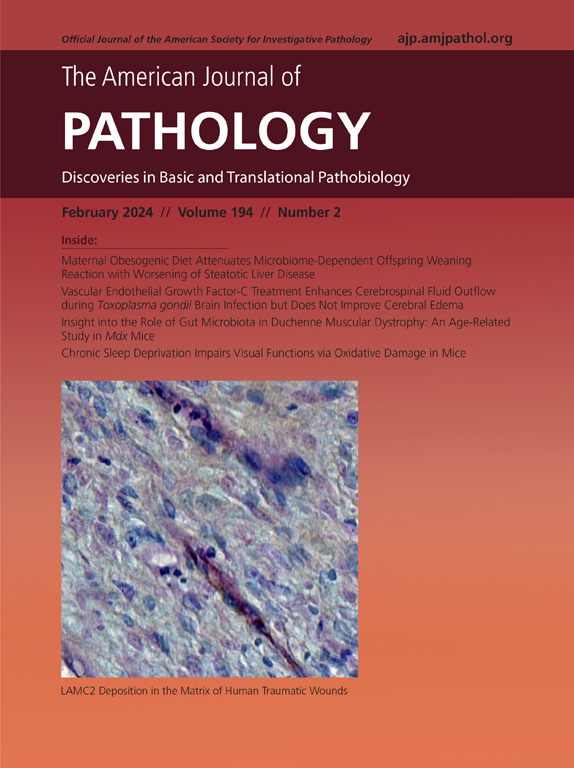The Angiofibrotic Switch in Retinal and Choroidal Vascular Diseases
IF 3.6
2区 医学
Q1 PATHOLOGY
引用次数: 0
Abstract
The angiofibrotic switch refers to the pathologic transition from active angiogenesis to fibrosis, a process that contributes to disease progression in retinal and choroidal neovascular diseases, such as age-related macular degeneration and proliferative diabetic retinopathy. This switch marks the replacement of newly formed, fragile blood vessels with fibrotic tissue, ultimately leading to scarring and permanent vision loss. Understanding this process is crucial, as fibrosis results in severe visual impairment and, currently, no anti-fibrotic therapies exist. Central to the angiofibrotic switch is endothelial-mesenchymal transition, a process where endothelial cells lose their vascular endothelial identity and acquire mesenchymal properties, contributing to extracellular matrix deposition and fibrosis. This review explores the cellular and molecular mechanisms underlying the angiofibrotic switch, emphasizing the interplay between angiogenesis, endothelial-mesenchymal transition, and metabolic dysregulation in driving fibrosis. Key mediators, such as transforming growth factor-β and vascular endothelial growth factor, are discussed in the context of their dual roles in promoting angiogenesis and fibrosis. This review underlines the need for early detection methods and targeted therapies to mitigate the angiofibrotic switch and improve outcomes in patients with neovascular retinal and choroidal diseases. By unraveling the complexities of this transition, this review aims to provide a framework for developing innovative diagnostic and therapeutic strategies to prevent fibrosis and mitigate vision loss in retinal and choroidal neovascular diseases.

视网膜和脉络膜血管疾病中的血管纤维化转换:血管生成和内皮-间充质转化的机制驱动因素。
血管纤维化转换是指从活跃血管生成到纤维化的病理转变,这一过程有助于视网膜和脉络膜新生血管疾病的疾病进展,如年龄相关性黄斑变性(AMD)和增殖性糖尿病视网膜病变(PDR)。这种转变标志着新形成的脆弱血管被纤维化组织取代,最终导致疤痕和永久性视力丧失。了解这一过程是至关重要的,因为纤维化会导致严重的视力损害,目前还没有抗纤维化的治疗方法。血管纤维化转换的核心是内皮-间质转化(EndMT),这是一个内皮细胞失去血管内皮特性并获得间质特性的过程,有助于细胞外基质沉积和纤维化。这篇综述探讨了血管纤维化开关的细胞和分子机制,强调了血管生成、EndMT和代谢失调在驱动纤维化中的相互作用。关键介质,如转化生长因子-β (TGF-β)和血管内皮生长因子(VEGF)在促进血管生成和纤维化的双重作用的背景下进行了讨论。这篇综述强调了早期检测方法和靶向治疗的必要性,以减轻血管纤维化转换,改善新生血管性视网膜和脉络膜疾病患者的预后。通过揭示这一转变的复杂性,本综述旨在为开发创新的诊断和治疗策略提供框架,以预防纤维化和减轻视网膜和脉络膜新生血管疾病的视力丧失。
本文章由计算机程序翻译,如有差异,请以英文原文为准。
求助全文
约1分钟内获得全文
求助全文
来源期刊
CiteScore
11.40
自引率
0.00%
发文量
178
审稿时长
30 days
期刊介绍:
The American Journal of Pathology, official journal of the American Society for Investigative Pathology, published by Elsevier, Inc., seeks high-quality original research reports, reviews, and commentaries related to the molecular and cellular basis of disease. The editors will consider basic, translational, and clinical investigations that directly address mechanisms of pathogenesis or provide a foundation for future mechanistic inquiries. Examples of such foundational investigations include data mining, identification of biomarkers, molecular pathology, and discovery research. Foundational studies that incorporate deep learning and artificial intelligence are also welcome. High priority is given to studies of human disease and relevant experimental models using molecular, cellular, and organismal approaches.

 求助内容:
求助内容: 应助结果提醒方式:
应助结果提醒方式:


